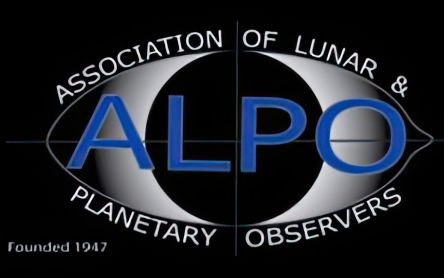Minor Planets Section Blog
Some of the highlights published in the Minor Planet Bulletin, Vol. 50, No. 4 (Oct-Dec 2023), are presented and represent the recent achievements of the ALPO Minor Planets Section.
Brian Warner finds that 2449 Kenos has a satellite with period of orbital revolution around its primary of 15.812 hours, and weaker evidence that 3225 Hoag might also have a satellite.
Jean-Baptiste Kikwaya Eluo and Carl W. Hergenrother have obtained B-V-R-I colors for the extreme Earth approachers 2020 BV14, 2023 HH3, 2023 HT3 and 2023 KQ and compared them with laboratory spectra of meteorites. For all except 2023 HH3, they obtained rotational lightcurves and found them to be rotating much more rapidly than the centrifugal limit at which centrifugal forces exceed gravity. They would disintegrate into tiny pieces if they were not solid rocks.
Peter Birtwhistle obtained CCD lightcurves of four other extremely tiny Earth approaching objects, 2023 HK, 2023 HU4, 2023 HO18 and 2023 KZ1, in two to four nights of their closest approaches. All of them are smaller than 200 meters in diameter, and all of them rotate more rapidly than the centrifugal limit and from which all surface debris would be cast off. Objects 2023 HK and 2023 HU4 show tumbling behavior in which the axis of rotation itself precesses about a second axis.
In addition to the asteroids specifically identified above, lightcurves with derived rotation periods are published for 117 other asteroids. Secure periods have been found for some of these asteroids, and for others only tentative or ambiguous periods. Some are of asteroids with no previously reported rotation periods; others are of asteroids with previously published periods that may or may not be consistent with the newly determined values.
Some of the highlights published in the Minor Planet Bulletin, Vol. 50, No. 3 (July-September 2023), are presented here and represent the recent achievements of the ALPO Minor Planets Section.
- Stephen Slivan, Claire J. McLellan-Cassivi, Miguel Serra-Ricart, and M. R. Alarcon have published a lightcurve inversion model of 1840 Hus. They find a sidereal rotation period of 4.749052 hours with the two ambiguous spin axes at celestial longitude 5 degrees, latitude +70 degrees and 195 degrees, +74 degrees, respectively.
- Peter Birtwhistle, Paolo Bacci and Martina Maestripieri, Milagros Colazo and 13 colleagues in the Grupo de Observadores de Rotationes des Asteroides (GORA), and Nick Sioulas obtained CCD lightcurves of five extremely tiny Earth-approaching objects, all smaller than 200 meters in diameter, on one or two nights of their closest approaches. All of them rotate more rapidly than the centrifugal limit and from which all surface debris would be cast off.
- Brian Warner and Robert Stephens found tumbling behavior for 3569 Kumon, (10302) 1989 ML, (66251) 1999 GJ2, (100756) 1998 FM5, (163692) 2003 CY18, (388945) 2008 TZ3, (464798) 2004 JX20, and 2018 XV5. Tumbling behavior occurs when the principal axis of rotation precesses around a second axis, usually a period differing from the axial rotation period by a factor less than 3.
In addition to asteroids specifically identified above, lightcurves with derived rotation periods are published for 81 other asteroids. Secure periods have been found for some of these asteroids, and for others only tentative or ambiguous periods. Some are of asteroids with no previous lightcurve photometry, others are of asteroids with previously published periods that may or may not be consistent with the newly determined values.
Newly found periods that are consistent with periods previously reported are of more value than the uninitiated may realize. Observations of asteroids at multiple oppositions widely spaced around the sky are necessary to find axes of rotation and highly accurate sidereal periods.
The year 2023 marks the 50th anniversary of the founding of the ALPO Minor Planets Section and the publication of the first issue of the Minor Planet Bulletin. Three people active in this Section since its founding have contributed commemorative articles.
Richard Binzel has been editor of the Minor Planet Bulletin since 1982.
Dick Hodgson founded the Section and edited the Minor Planet Bulletin from its founding until 1982.
Frederick Pilcher started observing asteroids and communicating with other asteroid enthusiasts five years before the ALPO Minor Planets Section was founded. He has been Section Coordinator (formerly Recorder) since 1982.
Peter Birtwhistle obtained CCD lightcurves of eight extremely tiny Earth approaching objects, smaller than 200 meters in diameter, all of which were superrotators with rotation periods less than 0.2 hours, and three of which exhibited tumbling behavior. The Lowell Observatory team of Brian Skiff, Kyle McLelland, Jason Sanborn, and Bruce Koehn found superrotation for two other Earth approachers.
Brian Warner, Michael Fauerbach, and Vladimir Benishek prepared a spin-shape model for 2764 Moeller, with a sidereal rotation period 5.953424 hours and mirrored pole positions at respective celestial longitude and latitude (3100, 410), (13300, 3900).
Brian Warner and Robert Stephens found possible satellites for 3533 Toyota and 85804 1998 WQ5, but more observations are needed to confirm their existence.
In addition to asteroids specifically identified above, lightcurves with derived rotation periods are published for 177 other asteroids. Secure periods have been found for some of these asteroids, and for others only tentative or ambiguous periods. Some are of asteroids with no previous lightcurve photometry, others are of asteroids with previously published periods that may or may not be consistent with the newly determined values.
